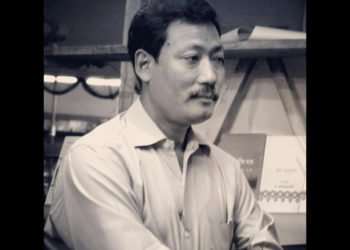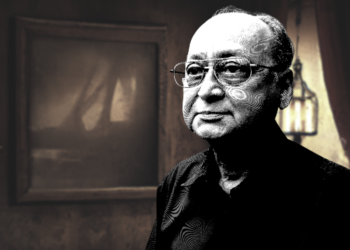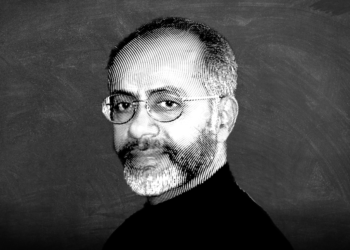It was a hot summer afternoon in Palestine/Israel. Close to 40 degrees Celsius. I was in the Jewish quarter of old Jerusalem near the Wailing Wall. Two men materialized in the deserted square. One of them was wearing a large fur hat – a distinguishing feature of the Polish Jews. A fur hat! In this heat! Surely there were no fur hats before the Chosen People were driven out of this land? The other person was a Rabbi in a black suit with curls dangling from the sides of his head. Instead of walking past me they stopped. The Rabbi asked me if I was from India. Satisfied with my nod he continued in a conspiratorial tone, “The term Brahman originates from Abraham.” He then repeated the words a couple of times lovingly rolling the “b” and the “r” on his tongue: “A-bra-ham, Brah-man, Abra-ham, Brah-man.” The message was clear. We in India are related to the father of the Semitic race and consequently to the Jews and the Arabs.
The Rabbi’s “revelations”, fascinating as they were, seem negligible compared to the research of some Russians and Ukrainians in their quest for “origins”. Terms such as Vedas, Vedic civilization, Vedic culture, Shudras and the Aryan race have entered the popular jargon in these regions, although the connotations attached to them would not be too comforting for some zealots in India.
Bal Gangadhar Tilak’s work, The Arctic Home of the Vedas (1903), inspired, perhaps by the American William Fairfield Warren’s book, Paradise Found: The Cradle of the Human Race at the North Pole (1885), is being extensively quoted by a section of Russians who are in search of a new identity. Excerpts from Tilak’s work have appeared in different journals to prove the point that the proto-Aryans were a white race or, to be more precise, Russian, and that the Russian/protoAryan civilization predates that of the Egyptians and the Sumerians. The debates in Russia are confined to the specific geographical regions where their “ancestors” might have settled after climatic changes forced them to move southward from their original home in the North Pole. Was it the steppes of Southern Russia, south of the Ural mountains, or somewhere between the Ukraine and Kazakhstan? The linguist O. N. Trubachev maintains that their habitation stretched along the Northern Coast of the Black Sea, the Crimean Peninsula and the Western Coast of the Azov Sea. To prove his point, Trubachev cites 150 place-names with linguistic parallels in Sanskrit.
What has gained rapid currency among many Russians is the notion that the Vedas were composed in parts of Russia, and not in India. They are referred to as the Slavic-Aryan Vedas, extracts of which were passed on to India 5000 years ago. Moreover, G. Grinevich, in his book Praslavyanskaya pismennost, published in 1993, claimed to have deciphered the Mohenjodaro script and solved its mystery. It transpired that the Indus Valley civilization was also that of the Slavs (read Russian), and the language was Slavic. We are told, in another work, that the famous and elusive “soma” drink is actually home brew made from fermented milk (samogon)! The word “russ” is from the Sanskrit – rooksha – white, fair-skinned; and the Russian word for Moscow – Moskva – is derived from moksha. And, finally, DNA results prove that Aryans were not only Russian but also brahmin.
Let us move on to the Ukraine. In 1996, Yu. Kanygin published a book with an innocuous title, The Path of the Aryans. The [role of] Ukraine in the Spiritual History of Mankind. Kanygin informs us that Rama, a Druid, was born in the northern Baltic regions. Appalled by the inhuman rituals of the Druids, Rama traveled to Europe, Egypt, and finally toward the banks of the River Dnieper in the Ukraine, which became his adopted homeland. At the time of his arrival in the Ukraine, Rama was 19 years old. The exact date of his arrival in the Ukraine was 5510 B.C. Within a year the local people could follow his sermons. Rama forbade human sacrifice, and instead introduced the festival of the Mother-Night. Rama spent 5 years in the Ukrainian lands before a voice from heaven bade him move eastward. That is how Rama came to India where, according to the author, he created a great civilization by uplifting the local people, teaching them ways of tilling the land, producing clay utensils and constructing shelters. Rama introduced technology, medicine, and even taught the locals the art of smelting metal. Most important, “he taught people civilized behavior.”
After his death, we are told, Rama was buried according to his wishes in the Ukraine, and not in some mountain in India or Scandinavia, where his body, according to legend, was brought by his disciples. Ukraine, the author states, was called Ramavarta or the country of Rama. Moreover, the Greek script is a modern version of Devanagari, which the Aryans (read Rama) introduced in the Ukraine. The Ukrainian language, Sanskrit, became the progenitor of all Indo-European languages and scripts. The second wave of the Aryans to the Ukraine was in the 3rd millenium B.C. By this time, Ukraine was known as Aratta or Oratania, which, its author maintains, is from the Sanskrit root Arati, i.e. the warrior. The Christian cross is a derivative of Rama’s symbol of a circle with four rays. Writers such as V. Paik, S. Plachynda and V. Ruban echo the same views, but go even further: the Aryan-Ukrainians’ rituals gave rise to Judaism, Hellenism, Christianity and Buddhism; and the Aryan-Ukrainian mythology is the progenitor of all mythologies.
Yu Shilov, another Ukrainian, is an archaeologist who has been researching the burial mounds (kurgans) in the region. Shilov believes that the burial mounds are those of the Aryans. Moreover, the Vedas were composed by the Ukrainian Aryans in mid-fourth millenium B.C. The author gives the exact location of the area where the Rig-Veda was composed: the left bank of the River Dnieper’s tributary, the Psla. Yoga, according to Shilov, also owes its origins to the same area in the Ukraine. The ancient Ukrainian festival Rakhman originates from Brahman, and Rakhmani was the name of the people of present day Ukraine. With the adoption of Christianity, many of the Vedic deities were incorporated into the Christian pantheon. Indra, for example, became St Andrei (Andrew).
Not surprisingly, an acrimonious debate has erupted between the Russians and the Ukrainians over all these claims and counter-claims. (Recently, there have also been Central Asian Turkic claims on their Aryan origins.)
Brahman, Abraham, Rakhman! Are we then Semitic, Slav or Ukrainian or all these rolled into one? Did we only briefly play host to Rama before his departure? Since so many erudite scholars are busy re-writing Indian history, they may find the Russian and Ukrainian theories of interest, and, perhaps, as valid as their own claims.
Note: This is a slightly edited version of a piece that was published on February 23, 2003,http://timesofindia.indiatimes.com/edit-page/LEADER-ARTICLEBRGaye-Rama-Aaye-Rama-Aryan-Myths-in-Russia-and-Ukraine/articleshow/38496774.cms




